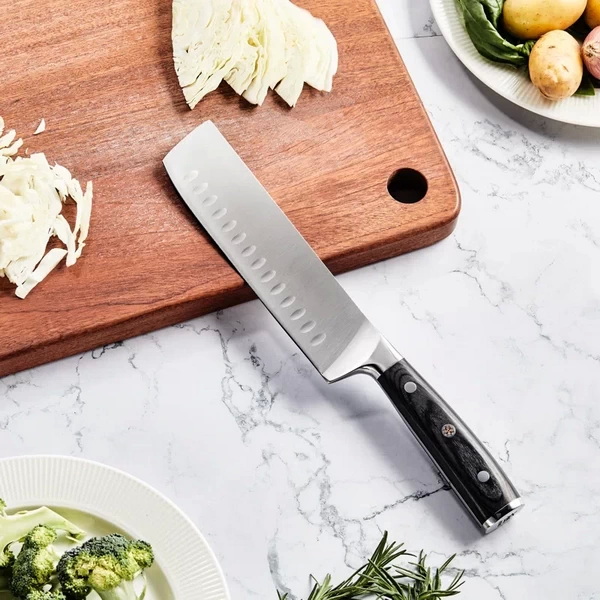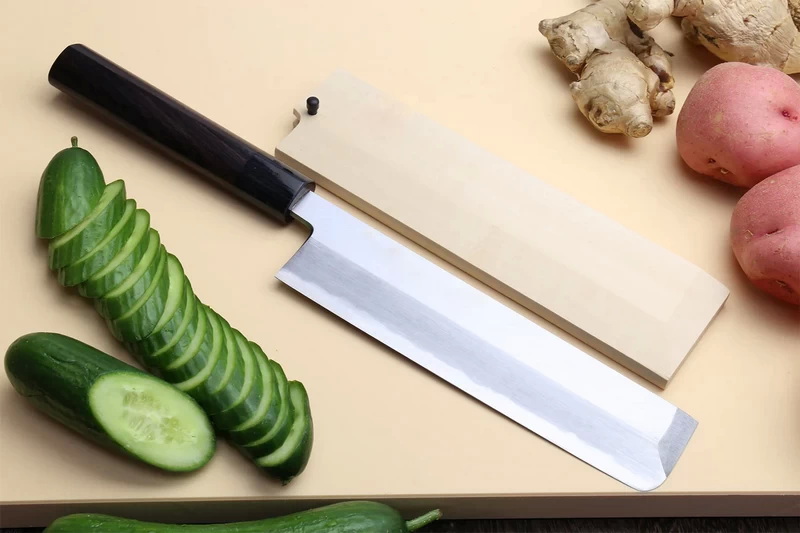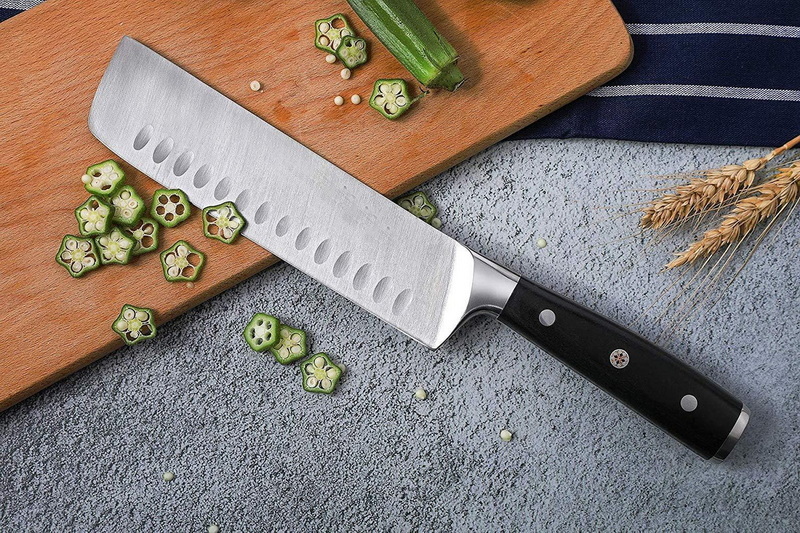

Views: 222 Author: Ella Publish Time: 2025-06-05 Origin: Site








Content Menu
● What Is a Japanese Vegetable Knife?
>> Key Features of the Nakiri Knife
● How to Hold a Japanese Vegetable Knife
● Basic Cutting Techniques for the Nakiri Knife
>> Push Chopping (Up-and-Down Motion)
>> Tap Chopping
>> Pull Cut (Optional for Certain Vegetables)
● Step-by-Step Guide to Using a Nakiri Knife
● Popular Japanese Vegetable Cutting Techniques Using Nakiri
>> Katsuramuki (Rotary Peeling)
>> Hangetsu-giri (Half-Moon Cuts)
>> Icho-giri (Ginkgo Leaf Cuts)
● Advanced Cutting Tips for Nakiri Users
>> Safety Tips
● Maintenance and Care for Your Nakiri Knife
>> Cleaning
>> Storage
>> Cutting Board Recommendations
● Advantages and Limitations of the Nakiri Knife
● FAQ
>> 1. What is the best way to hold a Nakiri knife for safety and precision?
>> 2. Can I use a Nakiri knife for meat or fish?
>> 3. How do I sharpen a Nakiri knife?
>> 4. What cutting board should I use with my Nakiri knife?
>> 5. How do I perform the katsuramuki technique with a Nakiri knife?
Japanese vegetable knives, especially the Nakiri, are celebrated for their precision, efficiency, and elegance in vegetable preparation. This detailed guide will cover everything you need to know about using a Japanese vegetable knife—from understanding its unique design and mastering cutting techniques to proper maintenance and care. Whether you are a home cook or a professional chef, learning to use a Nakiri knife will enhance your kitchen skills and make vegetable prep more enjoyable and precise.

The Japanese vegetable knife, most commonly called the Nakiri, is a specialized kitchen knife designed exclusively for cutting vegetables. The word "Nakiri" means "vegetable cutter" or "leaf cutter," highlighting its primary purpose.
- Blade Shape: Rectangular with a straight edge and a blunt, squared-off tip.
- Blade Length: Typically ranges between 6.5 to 7 inches (165 to 180 mm).
- Blade Thickness: Thin, allowing for clean, precise cuts without crushing vegetables.
- Weight: Lightweight compared to Western chef knives, reducing hand fatigue.
- Bevel: Usually double-beveled, suitable for both right- and left-handed users.
- Handle: Ergonomic and often made from wood or composite materials for comfortable grip.
The flat blade edge ensures the entire blade contacts the cutting board, producing perfect slices and preventing vegetables from catching or tearing.
A proper grip is essential for control, safety, and precision when using a Nakiri knife.
- Place your thumb and index finger on either side of the blade's base.
- Wrap your remaining three fingers around the handle.
- This grip offers maximum control and precision, especially for delicate vegetable cuts.
Avoid gripping the knife by the handle alone or placing your index finger on the spine, as these reduce control and increase the risk of accidents.
The Nakiri excels in chopping vegetables using a push-cutting motion rather than the rocking motion typical of Western chef knives.
- Hold the knife firmly with your dominant hand.
- Use a straight vertical chopping motion, pushing the blade down through the vegetable.
- Keep the flat blade edge in contact with the cutting board throughout the cut.
- This technique produces clean, even slices and is especially effective for leafy greens, root vegetables, and herbs.
- Move the blade straight up and down, tapping into the vegetable repeatedly.
- Useful for quick, repetitive cuts and dicing.
- Angle the knife slightly (about 45 degrees) and pull the blade toward you.
- This reduces drag and helps slices fall away cleanly, ideal for tomatoes and cucumbers.
- Use a wooden or plastic cutting board to protect the blade.
- Ensure the vegetable is stable by cutting it into manageable sizes and creating a flat surface to prevent rolling.
- Hold the vegetable with your non-dominant hand in a claw shape, tucking fingertips inward to avoid injury.
- Use your knuckles as a guide for the knife blade to maintain consistent slice thickness.
- With the Nakiri held in a pinch grip, use an up-and-down push chopping motion.
- Let the weight of the knife do most of the work; avoid forcing or sawing.
- For larger vegetables like cabbage, use the heel of the blade to guide the cut through thick layers.
- For slicing herbs or leafy vegetables, hold the knife further up on the blade for finer control.
- Use a gentle back-and-forth motion while maintaining the push chopping technique.
- Use the flat side of the blade or the spine to push chopped vegetables into a bowl or pan.
- Turn the knife upside down to use the back edge as a broom to keep your workspace tidy.
Japanese cuisine features various vegetable cutting styles that can be performed effectively with a Nakiri knife.
- Thin, continuous sheets are sliced from cylindrical vegetables like daikon or cucumber.
- Requires steady circular motion and control, often used for sushi garnishes or vegetable wraps.
- Circular slices from round vegetables like carrots or cucumbers.
- Usually thicker than other cuts, ideal for stir-fries or salads.
- Vegetables are halved lengthwise, then sliced into half-moon shapes.
- Common for soups and stews.
- Quarter-circle slices resembling ginkgo leaves.
- Used in soups and stews for aesthetic presentation.
- Randomly shaped cuts of uniform size to increase surface area for faster cooking.
- Great for curries and stews.

Achieving uniform slices is key to even cooking and professional presentation. Use your knuckles as a guide and keep your cutting motion steady and consistent. Practice makes perfect, especially with tricky vegetables like carrots or firm squash.
For large vegetables such as pumpkin or Chinese cabbage, the Nakiri's broad blade allows you to cut through thick layers quickly. Use the entire length of the blade and apply gentle pressure with the palm of your hand on the back of the blade if needed. Avoid forcing the knife; instead, let the sharp edge do the work.
- Always keep your fingers curled inward on the vegetable hand.
- Keep the knife blade clean and dry to avoid slips.
- Cut on a stable surface to prevent accidents.
Proper care will keep your Nakiri knife sharp and durable for years.
- Hand wash immediately after use with warm water and mild soap.
- Avoid abrasive sponges or steel wool that can scratch the blade.
- Dry thoroughly to prevent rust, especially for high-carbon steel blades.
- Store in a knife block, magnetic strip, or protective sheath.
- Avoid loose storage in drawers to prevent blade damage and accidents.
- Hone regularly with a ceramic honing rod at a 15-20 degree angle to maintain edge alignment.
- Sharpen with a whetstone when the blade dulls, maintaining the original bevel angle.
- Softer steel Nakiri knives are easier for beginners to sharpen.
- Use wooden or plastic cutting boards to preserve the blade.
- Avoid glass, stone, or ceramic boards that dull knives quickly.
Feature | Advantages | Limitations |
Blade Shape | Straight edge for clean, even vegetable cuts | Not suitable for meat or intricate cuts |
Weight | Lightweight for comfortable, long use | Larger blade surface may feel less agile |
Cutting Motion | Push chop for fast, precise slicing | Cannot perform rocking cuts |
Blade Tip | Blunt tip prevents accidental piercing | Limits detailed decorative cuts |
Versatility | Excellent for vegetables and herbs | Not ideal for bones or frozen items |
The Japanese Nakiri vegetable knife is a specialized tool designed to make vegetable preparation faster, safer, and more precise. Its flat, rectangular blade and lightweight design allow for clean, even cuts using a push chopping motion, making it ideal for slicing, dicing, and mincing vegetables and herbs. Proper grip, cutting techniques, and knife maintenance are essential to maximize its performance and longevity. Whether you are a beginner or an experienced cook, mastering the Nakiri knife will elevate your culinary skills and bring authenticity to your kitchen.

Use the pinch grip by placing your thumb and index finger on either side of the blade base and wrapping your other fingers around the handle. This grip provides control and reduces the risk of slipping.
No, the Nakiri is designed specifically for vegetables. Its thin, flat blade and blunt tip are not suitable for cutting meat, fish, or bones, which can damage the blade.
Sharpen using a whetstone, maintaining the original bevel angle (usually 15-20 degrees). Hone regularly with a ceramic rod to keep the edge aligned between sharpenings.
Use wooden or plastic cutting boards to protect the blade. Avoid glass, stone, or ceramic boards as they dull the knife quickly.
Hold the vegetable firmly and use a steady, circular peeling motion to slice thin sheets from cylindrical vegetables like daikon or cucumber. It requires patience and practice for even, thin sheets.